Published in Nacional number 675, 2008-10-20
Munich surgeon's new success
New breast of abdominal tissue
Milomir Ninkovic (51), one of the world's leading plastic surgeons, was in Split to present his revolutionary method of transplantation, which significantly improves the number of successful operations
 Milomir Ninkovic and his wife The Seventh Croatian Congress of Plastic, Reconstructive and Aesthetic Surgery has pooled many eminent and globally acclaimed plastic surgeons in Split, who discussed two topics over a five-day period – facial shaping and rejuvenation and breast surgery and reconstruction. Among the lecturers were well-known American surgeons, professors Foad Nahai, the president of the International Society for Aesthetic Plastic Surgery and Thomas Biggs, Ruth Graf of Brazil, and leading plastic surgeons from Italy, Spain, New Zealand, Finland, Germany, Sweden, Croatia, Slovenia, Serbia, Belgium and Switzerland. But the star of the congress was Dr. Milomir Ninkovic, head of the Department for Plastic, Reconstructive, Hand and Burn Surgery at Munich's Bogenhausen Hospital.
Milomir Ninkovic and his wife The Seventh Croatian Congress of Plastic, Reconstructive and Aesthetic Surgery has pooled many eminent and globally acclaimed plastic surgeons in Split, who discussed two topics over a five-day period – facial shaping and rejuvenation and breast surgery and reconstruction. Among the lecturers were well-known American surgeons, professors Foad Nahai, the president of the International Society for Aesthetic Plastic Surgery and Thomas Biggs, Ruth Graf of Brazil, and leading plastic surgeons from Italy, Spain, New Zealand, Finland, Germany, Sweden, Croatia, Slovenia, Serbia, Belgium and Switzerland. But the star of the congress was Dr. Milomir Ninkovic, head of the Department for Plastic, Reconstructive, Hand and Burn Surgery at Munich's Bogenhausen Hospital.
At a congress of German plastic surgeons in Stuttgart, and only a day later in Split, Professor Ninkovic, demonstrated his experience in the application of new microsurgery methods n the reconstruction of breasts with the patient's living tissue, where powerful microscopes are used to precisely monitor the flow of blood through even the smallest of blood vessels. This method, used now only at the clinic lead by the 51-year-old Dr. Ninkovic, is sure to see rapid global expansion. When the young plastic surgeon from Kosevo Hospital left wartime Sarajevo with his family in 1992, he had no idea that he would make his way in 2003 to Munich's respected Bogenhausen Hospital, following a stint at the University Hospital in Innsbruck, where only five years later he would be at the head of a team of twenty plastic surgeons with whom he is making breakthroughs in hand, breast and facial reconstruction. Milomir Ninkovic is known to the Croatian public as a surgeon who tried to overcome the tumour in the shoulder of the seventh Croatian Prime Minister, Ivica Racan. As a result of metastasis, however, it was to late to treat the primary seat of the illness. He arrived at the Split congress in the company of his wife Marina, a native of Sibenik and also a doctor specialising in physical therapy, the head of physical therapy at the University Hospital in Innsbruck, and a professor teaching at the local medical faculty.
NACIONAL: You have been to two congresses in two countries in just two days. How do you deal with so many obligations?
- Congresses are an opportunity to hear about new developments and discoveries, but are also important for our own training. But operations dates, clinics, lectures and congresses have to be juggled. I am in favour of setting the dates of plastic surgery congresses as much as two years in advance. The date of the next congress of German plastic surgeons has fallen on the same date as the Spanish congress in Valencia, where I promised to go six months ago, as the central topic will be allotransplantation, hand and upper extremities transplantation from deceased to living patients.
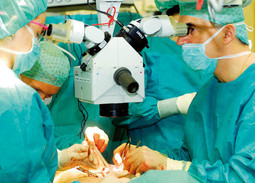 By monitoring the flow of blood during the transplantation, Dr. Ninkovic significantly reduces the possibility that the body might reject the transplanted tissue
By monitoring the flow of blood during the transplantation, Dr. Ninkovic significantly reduces the possibility that the body might reject the transplanted tissue NACIONAL: What did you tell the congress in Stuttgart?
- We presented the results of a comprehensive study of 50 operations and cases we have worked on recently at our clinic. It is a revolutionary development, ad we received a specially ordered microscope from the Karl Zeiss optics company for microsurgical operations, with which we can, by injecting a substance into the patient's body, immediately measure the level of blood flow of the transplanted tissue. That means that we can, immediately following the transplant or reconstruction operation, establish whether the tissue we have transplanted from once place to another is living normally, and whether there is normal blood flow in another part of the body, breast, face, lower leg. Everybody was interested in this new method right away.
NACIONAL: How was this done previously?
- Up to now, after the transplantation we were not sure how much of the new tissue had been accepted. In 30 percent of these kinds of operations some vascular problem would crop up, for example the problem of twisted blood vessels, which leads to damage to the tissue being transplanted. Now all of this is visible under this microscope. You control everything that happens in completely sterile conditions and can dynamically follow the situation on a monitor. Now we can monitor the blood vessels are placed right up to the level of the capillaries, and whether there are parts of the tissue that are now receiving a good flow of blood, and will die off in two to three weeks. Of course, these parts of the tissue are best removed immediately in the operation room. That leads to a greater success rate in the operations with fewer complications.
NACIONAL: How do you apply the new method in the reconstruction of breasts?
- We determine exactly which part of the lower abdomen is has the best blood flow and take it for the breast reconstruction. Usually we do not need all of the fatty tissue. That too is a development on which my team at the clinic is working. After this presentation in Stuttgart and Split I hope that they will also do so in other clinics. We have applied the method for some years now, but with a separate camera. Now the microscope, camera and monitor have been joined into a unit. Karl Zeiss initially produced the solution for neurosurgical operations, for operations of inborn anomalies of the blood vessels in the brain and aneurisms. When we saw that we asked Karl Zeiss to do the same for plastic surgery. Now, while the operation is ongoing, we control its outcome.
NACIONAL: What was the subject of the study of the first 50 operations using the new method?
- Most, about a third, on breast reconstructions, the rest on the reconstruction of the lower extremities, facial reconstructions, reconstructions of the lower jaw and soft tissue covering the face after the removal of facial tumours. The time of transplantation by rote in plastic surgery is behind us.
 Rado Zic, Milomir Ninkovic, Zdravko Roje, Janek Januszkewicz and Hilton Becker
Rado Zic, Milomir Ninkovic, Zdravko Roje, Janek Januszkewicz and Hilton Becker NACIONAL: How does plastic surgery improve the quality of life?
- It is important to achieve what the patient wants with the operation. We now have a much older generation of patients than 20 years ago, these are people from 60 to 90 years of age. At the start of my career the attitude was that that there was use in doing plastic surgery on patients over the age of 60. And at this moment 40 percent of the patients undergoing microsurgical procedures are over the age of 60. The world has changed. To this day there is a mistaken opinion the medical institutions attract patients to come to them. People today seek an individual surgeon, an individual physician for which they believe is the best in resolving their problem. A study has been carried out in Germany that shows that a good surgeon can keep a 250-bed hospital running. Clinics today take care to put the best people at the heads of their teams. There are 17 doctors working on my team. I know what any one of my colleagues can do best and direct them to sub-specialisations, hand microsurgery, burn treatment, microvascular procedures, aesthetic operations and breast reconstructions. The time of a hierarchy in leading a clinic is the past. The only way to earn authority is to be respected for your knowledge and skill. That is a situation in which the oldest surgeons call you into the operation room and ask: "Excuse me, professor, what would you do here?"
NACIONAL: When was the first time you found yourself in that kind of situation?
- They tested me as soon as I came to Munich in 2003. The first week, when I had just made my first rounds, I was called by the head of general surgery: "We have received a patient from Heidelberg who was released from the university clinic as inoperable, because she had a tumour of the colon which has penetrated to the floor of the pelvis. I am able to remove the tumour if you are ready to reconstruct the floor of the pelvis." I answered that there was no defect that a plastic surgeon was not able to reconstruct. "If that is the case", he said, "we will operate on the patient tomorrow."
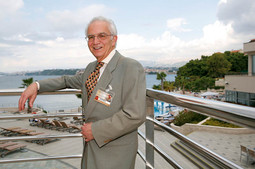 Foad Nahal
Foad Nahal NACIONAL: Has your method of breast reconstruction contributed to bettering the lives of patients?
- This is no longer the implantation of a prosthesis, but rather the transplantation of living tissue, where everything is monitored, even the level of blood flow. A patient can live after the amputation of a breast. Over 85 percent of women who have lost a breast do not undergo a reconstruction, as a result of not being informed, because they lack healthcare benefits or money. It is a question what kind of reconstruction you will opt for. Perhaps a dermal expansion and an implant. Two key problems arise when reconstructing breasts – skin and volume. The skin can be expanded and a volume added with an implant, and you can take both skin and volume from the abdomen, buttocks or thigh microsurgically. Very often I do a double breast reconstruction using tissue from the inside of the thigh, because the scarring is least visible there.
NACIONAL: What is better – a breast reconstruction using an implant or your own tissue?
- If you are working with implants, you have less scarring, but you have a foreign body in yourself. If you work with your own tissue, you get a much better appearance, but more scars. It is psychologically easier for women to have the breast replaced with their own tissue. All younger women, between the ages of 25 and 28, have to have their breast removed if a carcinoma appears. And survival after the illness is ever longer. If help is provided to them on time, these women are cured. That is why they want a final reconstructive procedure that will improve the quality of their life. Women do it for their own self-confidence and self-respect.
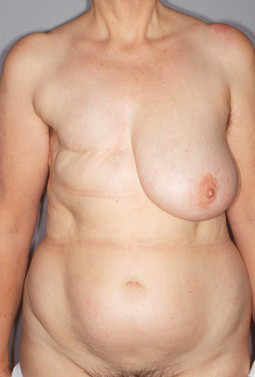 Before the reconstruction
Before the reconstruction NACIONAL: Why is tissue for reconstruction most often taken from the abdominal area?
- It all started in Sweden. Almost by chance. A patient asked Professor Hans Holmström why they threw away abdominal tissue after aesthetic surgery, why they did not take it and reconstruct breasts from it. He listened, and did so for the first time using microsurgery, not knowing at the time which anatomic area the best blood flow was present in tissue. It was a challenge for him. But the answer was in the tissue from the abdomen – it has the best blood flow. After he announced this, US surgeon started working on pedical lobes. They took the main muscle from the abdomen as the carrier of blood vessels and drew the tissue on this carrier through a tunnel on the reconstructed breast. The method is still used as a standard one in the US, and in Croatia. Back in 1998 at Harvard I wanted to see how they did it. In Innsbruck I normally did lobes that contained fatty tissue and skin. The blood vessels were isolated from the muscle. They did not use the method at Harvard at the time, feeling that the risk was too great. They have taken the method of pedical lobes to perfection.
NACIONAL: How does on choose the best breast reconstruction?
- An individual approach to the reconstruction is important. Each patient requires a different solution. If there is something I am unable to do, it is my duty to recommend another surgeon who can. There are women who do not have an excess of tissue on the abdomen, who are thin. Our new microsurgical method at the clinic in Munich offers a new level of safety to the patients and a new quality of reconstruction. I hope that our method with the Karl Zeiss microscope will be quickly transferred to other markets.
NACIONAL: Is there a possibility that a breast could be reconstructed one day with tissue from another person?
- My wife Marina and I were in Philadelphia recently, where we were invited as lecturers on allotransplantation, from one human body to another. Surgeons, immunologists and pathologists were invited, all those involved in the issue. Technically the transplantation is possible and the problem is not in the surgical part, but rather in the immunological aspect. The problem is in the rejection of an organ from another body. If you transplant two hands, you offer a person an entirely new quality of living. I defended the opinion that in these kinds of organ rejection conditions I would never transplant one hand if the other was healthy. The risk of getting a tumour is ten times greater. Why would I expose the patient to so great a risk if I do not offer them a significant improvement in their life. But the transplantation of two hands does. You have to balance between risk and benefit. With time we will succeed in achieving an immunological tolerance, which we cannot get at this moment. That is why taking tissue from another person is only possible for now hen saving a human life, it is an organ transplant, or a transplantation that significantly improves people's quality of living. These are double hand transplants and facial transplants.
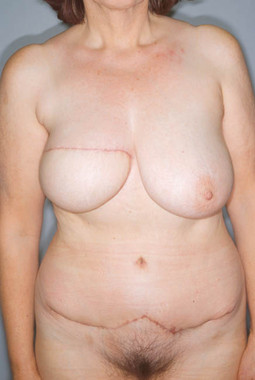 Forming the breast with visible incisions
Forming the breast with visible incisions NACIONAL: how did you get involved in the treatment of Ivica Racan?
- I was called by my colleagues from Rebro Hospital who asked if Racan could visit me at the clinic for an examination. We scheduled an examination on Friday and Mr. Racan was in Munich on Monday. We were surprised by the basic diagnosis. I looked at the pictures from the magnetic resonance and we quickly made an integral diagnosis: the area on account of which he had come to Munich was secondary and it was a metastasis of an advanced tumour. It was too late.
NACIONAL: What is your greatest success in the past year or two?
- I have now left the clinic. My greatest success is the great progress in fighting the illness of a young Italian. At the age of five he developed a malignant facial tumour. It was destroyed using radiation, but so was half of his face. He is a very dear and intelligent boy. I have already operated on him three times to reconstruct his face. We will build him a new face. After the third operation we have reconstructed the soft bone tissue, given him back his smile and symmetry, placed the nose centrally and created the upper lip. Another operation will be necessary to harmonise, balance the face. He is a student today and is so happy, because when he came to us, he was unable to open his mouth at all. I am connected to the case both emotionally and professionally, because I really want to help this young man. Of well-known people I operated recently on a member of the royal family in Saudi Arabia. I was in Riyadh for seven days working on the reconstruction of the lower part of the face f a young person who had received horrible burns.
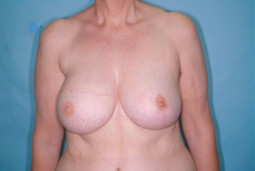 Complete reconstruction NACIONAL: How did you get to Innsbruck from Sarajevo?
Complete reconstruction NACIONAL: How did you get to Innsbruck from Sarajevo?
- Up to 1992 I worked as a plastic surgeon at the Kosevo Clinical Hospital in Sarajevo. The clinic was new and modern, built in 1984 for the Winter Olympic Games. And as there was cooperation between the Olympic cities of Innsbruck and Sarajevo, so did our clinics. Back in 1990 the head of the clinic in Innsbruck, Professor Hans Anderl, gave me the opportunity to operate in Austria as a visiting surgeon. Satisfied with my work, he invited me to stay on in Innsbruck or to come whenever I wished to. I did not accept the offer at the time. I did not speak German, and I was happy in Sarajevo, the clinic was working in excellent conditions, the working team was excellent, the kids were growing up without a care in the world, we lived and earned well. But when the war broke out I called Professor Anderl and asked if I could come. "My offer still stands", he said. I left Sarajevo on 21 August 1992. I am now in Munich.
Training and knowledge exchange
The seventh Croatian Congress of Plastic, Reconstructive and Aesthetic Surgery has gathered numerous eminent and globally recognised plastic surgeons in Split. Among the lecturers were well-known American surgeons, professors Foad Nahai, the president of the International Society for Aesthetic Plastic Surgery and Thomas Biggs, Ruth Graf of Brazil, and leading plastic surgeons from Italy, Spain, New Zealand, Finland, Germany, Sweden, Croatia, Slovenia, Serbia, Belgium and Switzerland.Latest news
-
28.10.2010. / 14:15
'A profitable INA is in everyone's interest'
-
28.10.2010. / 09:38
Sanader’s eight fear SDP — Won’t bring down Government
-
21.10.2010. / 15:02
Interior Ministry turned a blind eye on Pukanic assassination
-
20.10.2010. / 09:34
Barisic could bankrupt HDZ



